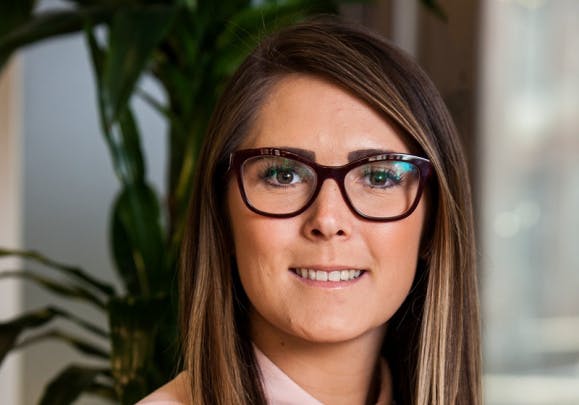Lesley Duncan is the strategy director at ForwardPMX, a brand performance agency. We caught up with Lesley to find out how Covid-19 has impacted her working life.
Please describe your job: What do you do?
I’ve recently been appointed as the new Strategy Director within our Client Teams function in our London HQ. The scope of my role is wide, and you could say I have my finger in all pies so to speak! I participate in everything from new business, to leading in client strategy as well as internal responsibilities, such as facilitating training and coordinating teams so they’re set up for success.
This is a particularly exciting time for the agency as our newly expanded Client Teams function will see us invest more heavily in strategy, planning and business intelligence to provide even stronger integrated offerings to clients..
Working alongside our FP Consultancy arm, I’m exposed to some interesting projects, particularly during a time when clients are becoming more digitally savvy and want us to truly become an extension of their own teams. We’ve supported many brands through some major unforeseen challenges over the last several months and through key stages of digital transformation, enabling our teams to engage in more elevated levels of conversation with clients – one that expands our traditional remit beyond media, where we’re having discussions focused on the right data strategies and technology partners, and how we can support brands’ larger business aims. This is a truly exciting shift to see happening, and one that I believe is going to be so important for how agencies and brands partner in the future.
How has your typical day been impacted in the short term by the pandemic?
For me personally, it took a couple of months to adjust to this new way of working. I would say it’s really important to invest in your set up, as we don’t know exactly how long this will go on, so if that means getting a second screen and setting up a separate work space in your home – do it! You’ll thank yourself later.
At the beginning of the pandemic, I underestimated the importance of a proper routine, which in turn, affects output. I’ve now made sure I keep to small routine changes, such as ensuring that I wake up earlier to get some exercise in before work. It has an amazing ability to change my mood. Other small changes include mini breaks away from the screen every two hours, asking for meetings to start a little later or finish earlier to give people some time back, but most importantly, it’s to be okay with giving yourself a break. Burnout is real, especially during a pandemic.
Another team communication hack has been holding “walking meetings”, so people don’t always feel they need to be glued to their desk chairs. This was adapted from when we were in the office, where I’d often ask if someone wanted to walk around the block while we talked.
What trends have you seen in the last few weeks in your sector?
Podcasts have become a lot more popular recently due to a mid-lockdown slump in movie streaming services. But the question is, are brands set up for audio and voice advertising? There’s lot to explore here, and brands need to assess the right platforms to reach their customers and be set up to do this in the long term.
The role of physical stores will need to be reevaluated, and the pandemic has only heightened this need. Stores will be a lot more experiential, a destination that lends to the opportunity to meet designers, influencers or test new products. It’s the prime time to connect with customers, particularly Gen Z, who want to connect with brands who share the same attitudes on society and changes we’re seeing in the world. Big sports retailers have adopted this with product ranges that are made from purely recyclable materials, emphasising how brands should be taking a lot more ownership and accountability of societal issues, but only if it’s from an authentic place that aligns with their values.
The final one would be the increased presence of payment providers in the retail space, given financial strains impacting people because of Covid-19. Where customers are unable to try on clothing in-store, they turn to using the payment provider such as Visa, Clearpay, Paypal and Klarna where you can pay later for clothes you purchase now, while trying on clothes from the comfort of your own home.
What advice would you give a marketer right now?
As we’re in a state of transition, it’s always wise to keep on top of research. Platforms such as Facebook, Spotify and Global Web Index are always releasing new content, so stay in the know and fit reading into your routine – even if it’s during your morning cuppa!
The digital landscape requires marketers to use data effectively to learn, target and interact with their audiences. But as consumers continue to shift digitally, the way this data is used will also evolve, creating new challenges and opportunities to understand customers, improve their experiences and ultimately drive sales. Covid-19 has caused greater urgency to get the right tools, partners and management strategies in place to ensure brands are well positioned to leverage first party data strategies, with consent as a key focus.
What does long term planning and strategy look like now at your brand?
Future conversations with brands will focus on long term strategy, their digital maturity and the importance of data to be able to connect with customers relevantly. As digital has become many brands’ primary touchpoint over the last couple of months, they need to explore ways to hold onto the customers gained during this period.
Customer experience will play an ever more important role, with every touch point becoming more important when it comes to creating a consistent experience. Brands should consider the way in which customers research and respond to campaigns and make the experience as immersive and responsive as possible. AI and its adoption will become more prevalent with the use of chatbots, but it’s about how you use it to influence how customers interact with your brand. Customers now expect more one-on-one relationships with who they buy from, enabling an opportunity for a true value exchange. Brands who demonstrate they have a clear vision and are ready for change will succeed.
Forecasting will become more dynamic, and given unreliable data we have this year, strategies that have worked in the past aren’t a sure-fire way to success anymore. But with the right data management strategies, brands can be in a better position to monitor behaviours closely and predict future outcomes on a granular level.
What are your favourite tools and techniques to help you get your work done at the moment?
There’s a great time management technique called ‘Rocks, Pebbles, Sand’ that really helps me manage my time. The big tasks are the rocks, the pebbles are smaller tasks, and the sand is much smaller tasks like responding to emails, and I aim to get one rock completed a day to stay on top of my task list.
I also swear by One Note to stay super organised. It enables you to house all your client information and meeting notes in one place. I also like to use a physical notebook too – there’s nothing quite as satisfying as physically crossing something off your to-do list! There’s also a great planning tool extension on Teams, conveniently called Planner, that lets you manage, assign tasks and set deadlines directly from Teams which helps with remote working too.
There’s also a great project management tool popular among brands, Asana – enabling you to manage all your teams’ work in one place, again setting task owners, and adding milestones with detail. The final tool I have recently started using is great for remote team collaboration, it’s called Miro. You can essentially use it like a white board – oh there are times when I miss that interaction of ideation in a meeting room!
Which companies have impressed you during the pandemic?
Some great examples that come to mind include… Ben & Jerry’s: The brand had a strong stance on the Black Lives Matter movement. They were bold, proactive in their response, authentic and they made commitments straight away.
Nike: A new campaign showcased a pregnant mum with the caption ‘Made for the toughest athletes’ with a full-size and baby Nike Swoosh to symbolise inclusivity in a fun way.
Courtney Black: An Instagram fitness coach, who really crushed lockdown and helped many people figure out their new workout routines early on. She incorporated her paid app which added value to the free sessions she was running online and enabled a great integrated experience for users.
What changes are you making to help your company connect with how people are feeling and experiencing the pandemic?
In difficult times such as these, communication and transparency are key. We’ve been committed to providing staff with regular business updates on both regional and global levels, to help our employees feel more connected around the world, and we’ve encouraged stronger communication flows by setting up more working groups for different areas of our business.
Additionally, my team has organised morning stand-ups, where we allocate time for different sessions. For example, Mondays are for team meetings that look forward to the week ahead, on Wisdom Wednesdays, we share work we’re proud of, topical content, or stats of the week. Then we have Fun Fridays at lunch where it’s a lot more casual, and we would have a partner come in to present their latest offering and share some funny gifs or jokes! We also arranged a social distanced team picnic and have held lunchtime workouts together to improve our team interaction.
To help navigate brands through this time, we held webinars and virtually opened our doors to clients and prospects in an educational approach. We really leaned in with solving problems on a macro scale that affects everything from digital to business operations. The last webinar I participated in discussed 1st party data and the death of the cookie.
The goal is to help brands become true multi-moment advertisers, something that only 2% of brands in Europe are achieving right now. A true omnichannel experience connects offline with online, syncs brand comms and performance comms to ensure no disconnect between messaging and organises tech and stakeholders by realising their true ambitions and goals.








